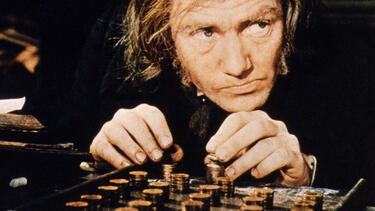Three Questions: Prof. X. Frank Zhang on the Drop in Charitable Giving
Adjusted for inflation, charitable giving in the United States fell by 1.7% in 2018, the first decrease since the Great Recession. According to Giving USA, donations from foundations and corporations rose, but giving from individuals fell by 3.4%, adjusted for inflation. We asked X. Frank Zhang, a professor of accounting at Yale SOM, what explains the decline and how policymakers can encourage more giving.

Albert Finney in the title role of the 1970 film "Scrooge." Photo: LMPC via Getty Images.
What do you think accounts for the drop in individual charitable giving last year?
Charitable donation by Americans declined 1.7% in 2018 despite a strong economy. I think that there are two major reasons for this decline. The first reason is the Tax Cuts and Jobs Act of 2017, which brought significant changes to the American tax code. While charitable donation is still tax deductible, the 2017 tax act doubles the standard deduction from $12,000 to $24,000 for married couples filing jointly. The 2017 tax act does not materially affect wealthy donors as they continue to itemize their tax deductions and thus can fully deduct their charitable donations. However, middle-class families are less likely to donate as they now opt for the standard deduction and thus no longer receive a specific tax benefit for charitable giving. The second reason is the poor performance in the stock market. The S&P 500 index was down 6.24% in 2018. Americans tend to donate less in bear markets than in bull markets.
Has charitable giving risen and fallen in response to changes in the tax code in the past?
Charitable giving does respond to changes in the tax code. Itemization status and marginal tax rate are two major factors that determine how a taxpayer’s charitable donation will be treated. From the historical perspective, marginal tax rates change over time. As the marginal tax rate increases, the incentive to donate also increases. To understand this logic, let’s take cash donation as an example. If a taxpayer’s marginal tax rate is 35%, one more dollar in charitable giving reduces taxable income by $1 and tax by $0.35, suggesting an after-tax cost of $0.65. Therefore, the higher the marginal tax rate, the lower the after-tax cost for the donor. Figure 4.2 of Fack and Landais (2012) shows a strong positive correlation between the marginal tax rate and reported donation as a fraction of total income for top 0.1% of richest taxpayers in the U.S., who account for a vastly disproportionate share of total charitable donations. When the marginal tax rate dropped from 42% in 1986 to 21% in 1987, reported donation as a fraction of total income declined from 12% to 7%.
If the tax code is a good way to encourage people to make charitable donations, how would you adjust the law to maximize giving?
The key is to make charitable giving truly tax deductible. Lowering the standard deduction and increasing the tax rate would encourage people to make more charitable donations, but would essentially increase people’s tax burden. One better approach would be to relax limits on tax deductibility of charitable giving. Under the current tax code, total charitable deduction cannot exceed 50% of a taxpayer’s adjusted gross income. Relaxing this limit will certainly encourage some people to make more charitable donations.